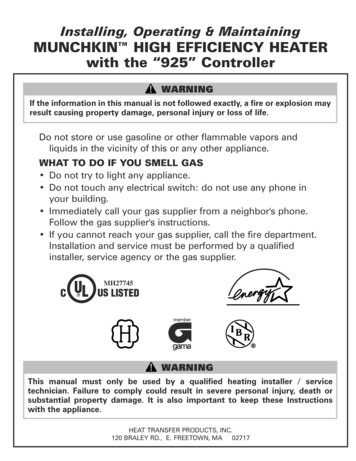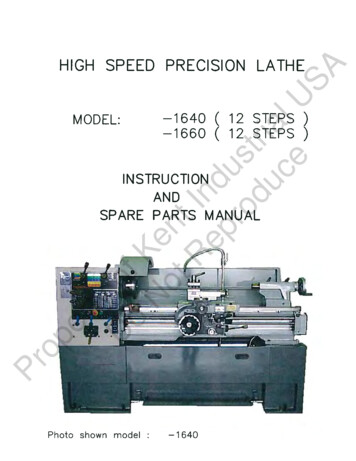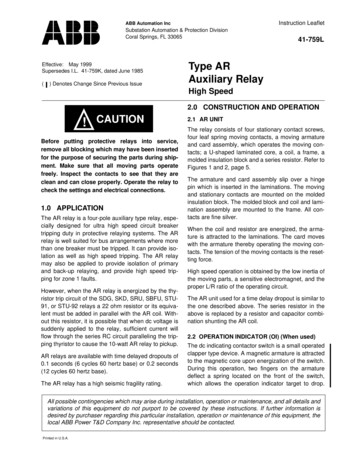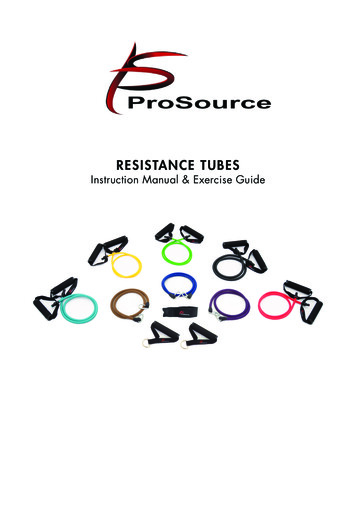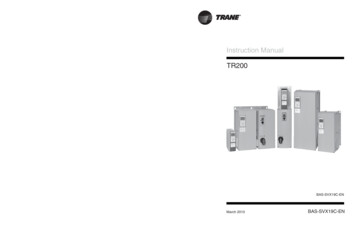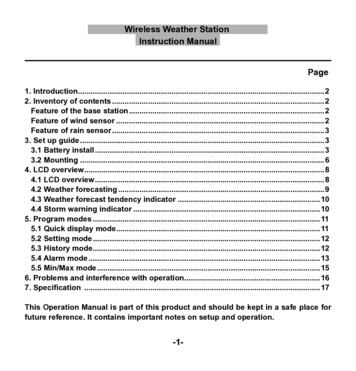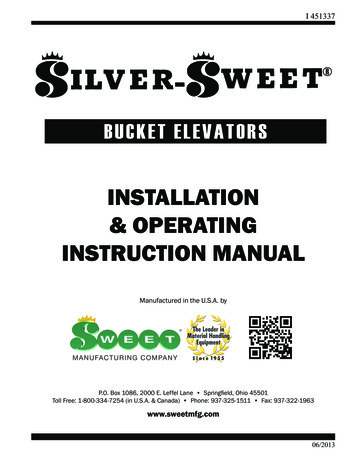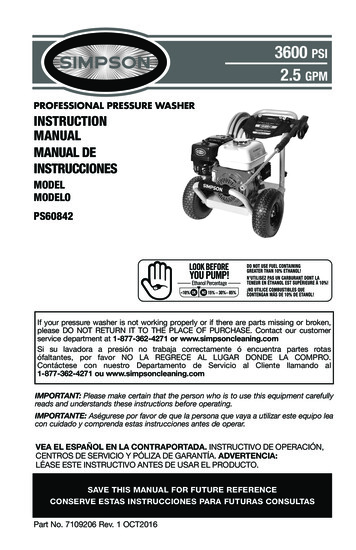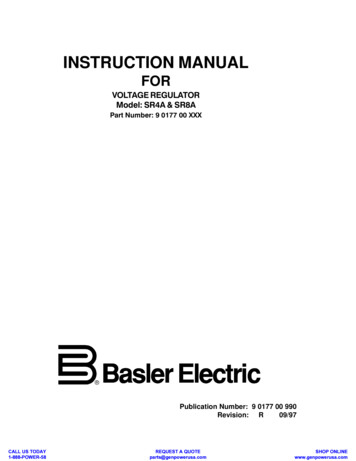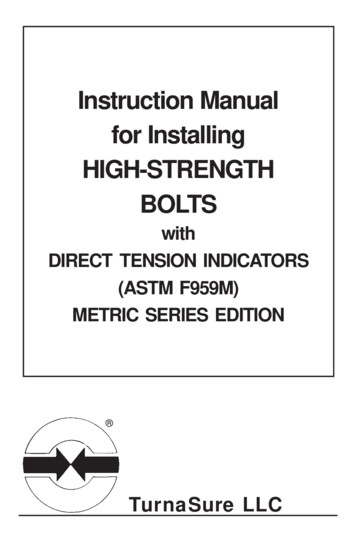
Transcription
Instruction Manualfor InstallingHIGH-STRENGTHBOLTSwithDIRECT TENSION INDICATORS(ASTM F959M)METRIC SERIES EDITION TurnaSure LLC
TABLE OF CONTENTSIntroduction . 1Theory of High-Strength Bolting . 2Direct Tension Indicators (DTIs) . 3Bolt Tensioning Using Plain Finish DTIs . 6Bolt Tensioning Using Coated DTIs . 9Recommended Bolt Installation Procedure. 12Problems Commonly Encountered WhenTensioning Bolts . 14Tool Selection and Performance . 16Checking for Specification Conformance . 17DTI Identification Markings . 20Installation Instructions for Bridge Applicationsper AASHTO .Inside Back Cover TurnaSure LLCInternational Headquarters340 E. Maple Ave., Suite 206Langhorne, PA 19047Phone: 215-750-1300800-525-71939th Ed.June 2008Fax: 215-750-6300Email: info@turnasure.comWebsite: www.turnasure.com
INTRODUCTIONHigh-strength bolts are well established as economical and efficient devices for connecting structural steel. When North Americandesign and construction practices are followed, the Specification forStructural Joints Using ASTM A325 or A490 Bolts, Approved by theResearch Council on Structural Connections, sets the basic rules fortheir use. Designers and inspectors should be thoroughly familiarwith this specification.Direct Tension Indicators (DTIs) are recognized by many engineers as the most reliable method for ensuring correct installation ofhigh-strength bolts according to that specification for bothshear/bearing connections and connections requiring fully pretensioned bolts.This manual is written for engineers, construction superintendents, inspectors and iron workers to assist them in the properinstallation of high-strength bolts using DTIs. This will ensure thatbolts have been tensioned to the values required whether used inslip-critical connections, connections subjected to direct tension, orshear/bearing connections requiring fully pretensioned bolts. Theseinstructions are also valid when DTIs are specified for use with highstrength bolts in other connections as a device to ensure that all boltshave actually been tensioned.The handbook discusses the theory of slip-critical connectionsor connections subjected to direct tension, proper installation ofDTIs, general rules for bolt installation, problems typically encountered when installing high-strength bolts and many other subjects relative to high-strength bolting.TurnaSure LLC has years of high-strength bolting experienceand provides a range of consultation activity including seminars, sitevisits, tool recommendations, specification commentary and trainingprograms. In addition TurnaSure LLC prepares instructional DVDs,published technical reports and articles for publication in trade journals. Should you wish to receive any of this information or be placedon our mailing list, please contact us at the address shown on theinside cover.An inch series edition of this manual is available upon request,or you can print the PDF version available on our web site.1METRIC
THEORY OF HIGH STRENGTH BOLTINGThe principle of slip-critical connections relies upon tensioningeach bolt in the connection to a specified minimum tension so thatthe desired clamping force will be induced in the connection interface. Shear loads are then transferred by frictional resistance in thejoint interface rather than by bearing on the bolt shanks and holefaces. In this type of connection there will be no movement of theconnected materials when the connection is subjected to theseloads. Movement in many types of joints is highly undesirable, hencethe development of the slip-critical connection. (Figure 1)Figure 1When tension loads are applied in the direction of the bolt axis,tensioning to a specified minimum tension is also important, particularly if the loads are cyclical and could induce loosening or fatiguefailure of the bolts. The clamping force at the specified minimum tension should be greater than the applied loads. This will prevent theplies from separating or the bolts from developing any significantincrease in tension stress over the installed pretension stress.(Figure 2)Figure 22METRIC
DIRECT TENSION INDICATORS (DTIs)Direct Tension Indicators (DTIs) are simple and extremely accurate devices for ensuring that bolts have been installed above thespecified minimum tension value. Used properly they positivelyensure the correct amount of clamping force. Readers whohave installed high-strength bolts using “torque/tension” valueswill notice that this manual does not relate torque to tension.Torque, or twisting force, is not a reliable measure of bolt tension. DTIs measure tension regardless of applied torque.A DTI is a hardened, washer-shaped device with protrusions,“bumps,” pressed out on one face, manufactured according to theprovisions of ASTM F959M. The fact that it resembles a washer isincidental. It is, in fact, a precision made mechanical load cell, adevice for tensioning which is covered by an ASTM Standard.When a DTI is installed on a bolt with the “bumps” placedagainst the underside of the bolt head there are noticeable gapsbetween the “bumps.” As the nut is turned and the bolt tensioned, the“bumps” flatten. When the “bumps” are flattened so that the gapshave been reduced to the required dimension, the bolt has beenproperly tensioned and required clamping force is present. A DTIdoes not make it more difficult to tension a bolt, it merely shows thatthe bolt has been properly tensioned. (Figure 3)Figure 3Direct Tension Indicators are supplied either “plain finish,” thatis without a coating, mechanically galvanized to ASTM B695 Class 50,or produced from “weathering steel” for use with Type 3 high-strengthbolts. Other coatings may be available upon inquiry.3METRIC
Unless otherwise specified, uncoated DTIs are installed underthe bolt head and the nut turned. When the bolt is properly tensionedthe gap will be less than 0.400mm in more than half of the spaces.Coated DTIs are installed using a 0.125mm criteria. To assure thatthe DTI is properly installed, feeler gages, 0.400mm and 0.125mmthick, are provided with DTI shipments. To ensure that the DTI isproperly compressed, and the bolt tensioned, the appropriate feelergage must be refused in a given number of gaps between the“bumps.” (Table I lists the number of “bumps” for each size and gradeof DTI and the required number of gage refusals in the gaps.)Table 1BoltSizeTYPE 74M3685*Not currently in ASTM for bolts or DTIsTYPE 10.9BumpsRefusals4466778933444455Should the specifications or conditions of installation call for anaverage gap of less than 0.125mm the feeler gage must be refusedin all spaces.M-22 8.82H10.400 mmFigure 4When inserted the feeler gage must be pointed at the center ofthe bolt and be at the center of the space. “Notches” in the O.D. ofthe DTI assist in feeler gage inspection. (Figure 4).4METRIC
Usually, installation crews develop a “feel” for installation andcan install DTIs to the correct gap by eye. Inspectors will want to verify that the correct gap has been achieved using a feeler gage on alimited number of DTIs and then compare other gaps by eye.Fully compressed DTIs should not be rejected. Someinspectors judge that a bolt which has fully compressed a DTI is“overtensioned.” No specific definition of “overtensioned” exists inbolt literature. Many experts believe that unless a tensioned bolt hasbroken it is acceptable. Further support for this recommendation canbe found in a report published in Volume 36, No. 1 of the EngineeringJournal, The Effects of Over-Compressing ASTM F959 DirectTension indicators on A325 Bolts Used in Shear Connections.REUSE OF DIRECT TENSION INDICATORS ONHIGH STRENGTH STRUCTURAL BOLTSThe question has been raised as to whether it is permissible toreuse Direct Tension Indicators (DTIs). This notice is intended to clarify that the reuse of DTIs is not recognized by this manufacturer as aviable and accurate means to assure that required clampforce hasbeen generated in slip-critical or tension connections. DTIs, like otherfasteners, plastically deform during use. Thus, reuse of such fasteners cannot be assumed to be sound engineering practice.Admittedly, the RCSC Specification is currently silent on the issue ofreuse of DTIs, or for that matter, Twist-Off bolts.5METRIC
BOLT TENSIONING USING PLAIN FINISH DTIsMETHOD #1DTI Under the Bolt Head–Turn the Nut to TensionFor multiple plies and long bolts (typically largeA490M bolts) this method will detect trapped bolts.ASSEMBLYPut the DTI under the bolt head with the bumps facing the undersideof the bolt head. Put a hardened washer under the nut. (Figure 5a)With a short-slotted or oversized hole under the bolt head add a hardenedflat washer between the DTI and the hole, and if the bolt is also an A490Mlarger than M24 the hardened washers must be at least 8.0mm thick. (For along-slotted hole, an external cover plate of sufficient size to completelycover the slot should be provided at a minimum of 8mm thick). (Figure 5b)Check that the washer hole diameter conforms to ASTM F436M forsizes up to M24. Above M24, because ASTM F436M allows a washer I.D. considerably greater than the nominal diameter of the bolt, theengineer may wish to consider “special” hardened washers with normalsized holes. TurnaSure can assist in procurement of such washers.Normal sized holes either in a washer or in the structured steel alsohelp prevent DTIs from dishing.OversizeholeFigure 5aFigure 5bTENSIONINGTurn the nut until the gap between the bolt head and the DTI face isreduced to less than 0.400mm in more than half of the entry spaces.When turning the nut, prevent the bolt head from spinning with a handwrench.6METRIC
BOLT TENSIONING USING PLAIN FINISH DTIs (Continued)METHOD #2DTI Under the Nut–Turn the Nut to TensionUse of this method saves the need for a hardened washer on standard connection not involving mutliple plies or large A490M bolts.ASSEMBLYPlace the DTI under the nut with the bumps facing the nut.(Figure 6a)With a short-slotted or oversized hole under the bolt head or nut, add ahardened flat washer, and, if the bolt is an A490M and larger than M24 thehardened washers must be at least 8.0mm thick. (For a long-slotted hole,an external cover plate of sufficient size to completely cover the slotshould be provided at a minimum of 8mm thick). (Figures 6b and 6c).Note B: The new TurnaSure DTIs do not need hardened washers betweenthe nut and DTI. This assembly was for DTIs with the older design“straight-sided” protrusions (as depicted in Figures 12 and 13 on page 20).With the old design DTIs a hardened washer has to be used between thenut and DTI to achieve consistent assembly loads.OversizeholeNote AFigure 6aFigure 6bFigure 6cTENSIONINGTurn the nut until the gap between the nut and the DTI face is reducedto less than 0.125mm in more than half of the entry spaces. Whenturning the nut, prevent the bolt head from spinning with a handwrench.7METRIC
BOLT TENSIONING USING PLAIN FINISH DTIs (End)METHOD #3DTI Under the Bolt Head–Turn the Bolt Head to TensionUse this method if method #1 or #2 can not be used.ASSEMBLYPlace the DTI under the bolt head with the bumps facing the bolthead. (Figure 7a)With a short-slotted or oversized hole under the bolt head or nut, add ahardened flat washer, and, if the bolt is an A490M and larger than M24the hardened washers must be at least 8.0mm thick. (For a long-slottedhole, an external cover plate of sufficient size to completely cover the slotshould be provided at a minimum of 8mm thick). (Figures 7b and 7c)Note B: The new TurnaSure DTIs do not need hardened washers betweenthe nut and DTI. This assembly was for DTIs with older design “straightsided” protrusions (as depicted in Figures 12 and 13 on page 20). With theold design DTIs a hardened washer has to be used between the nut andDTI to achieve consistent assembly loads.Note BOversizeholeFigure 7aFigure 7bFigure 7cTENSIONINGTurn the bolt head until the gap between the bolt head and the DTI isreduced to less than 0.125mm in more than half of the spaces. Whenturning the bolt head, prevent the nut from spinning with a handwrench.8METRIC
BOLT TENSIONING USING COATED DTIs OR TYPE-3WEATHERING STEEL DTIsMETHOD #1DTI Under the Bolt Head–Turn the Nut to TensionCoated DTIs should be assembled under the bolt head whereverpossible. Assembly and tensioning should proceed as with “plain.”For galvanized and epoxy coated or weathering steel DTIs the gapbetween the bolt head and the DTI face should be reduced to lessthan 0.125mm in more than half of the entry spaces. (Figure 8a)*The use of flat hardened washers per the provisions of the RCSCSpecification varies with the bolt strength, hole size and yield strength ofconnected steel and tightening method. For example, with a short-slottedor oversized hole under the bolt head add a hardened flat washer betweenthe DTI and the hole, and, if the bolt is an A490M and larger than M24 thehardened washers must be at least 8.0mm thick. (For a long-slotted hole, anexternal cover plate of sufficient size to completely cover the slot should beprovided at a minimum of 8mm thick). (Figure 8b)For bridge applications see INSTALLATION INSTRUCTIONS FORBRIDGE APPLICATIONS PER AASHTO, found on the inside backcover.OversizeholeFigure 8aFigure 8b9METRIC
BOLT TENSIONING USING COATED DTIs OR TYPE-3WEATHERING STEEL DTIs (Continued)METHOD #2DTI Under the Nu
have installed high-strength bolts using “torque/tension” values will notice that this manual does not relate torque to tension. Torque, or twisting force, is not a reliable measure of bolt ten-sion. DTIs measure tension regardless of applied torque. A DTI is a
